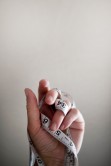How To Take Your Body Measurements For Weight Loss

See: How Often Should I Weigh Myself?
Sometimes you’ll see a significant difference in your measurements even though the scale hasn’t budged an inch! This is because as you work out and tone up, you build muscle mass – and muscle will take up less space on your body than fat does. You’ll be surprised to see the inches falling off. Your clothes will fit loosely, and it’s fun to see your measurements evolve with your overall progress.
There are about ten important body measurements you can take and compare as you continue on with your weight loss journey. You don't have to track all ten if you don't want to, but aim for at least one leg, one arm measurement, as well as your hip and waist measurements.
If that's still too much, do your hip and/or waist measurements. You can use your waist/hip ratio as a way to track your progress, plus you can use it as a health goal to aim for. Your waist/hip ratio can determine your risk for certain diseases.
See: Calculate Your Hip/Waist Ratio
Some Tips When Taking Body Measurements
- While you're measuring your body, don't tense up. Relax and you'll get a more accurate measurement each time.
- Take the measurements, record them somewhere safe -- and then forget about them. Put your scientist hat on and look at the numbers objectively over time.
- Use the same spots each time you take the measurements. Look for a "landmark" spot for each measurement -- for example, I have a little beauty mark on my thigh that I use to take my thigh measurement.
- Use a good quality body measuring tape. I recommend the Myotape measuring tape or something similar. That old, cloth measuring tape that's been sitting in your sewing box for 20 years just won't cut it.
- Check your progress every four to six weeks. Look at the numbers objectively over a period of four to six weeks and see how you're doing.
How To Take Your Body Measurements
Let’s start from the bottom and work our way up:
- To measure your calves, simply find the largest are to measure each time.
- Work your way up to your knees just above the kneecap and take a measurement there.
- The thighs are next! Just like the calves, simply find the largest area to measure.
- Now take a measurement at your hip area. Like the calves and thighs, just find the biggest area to measure.
- Your midsection is the area between your hips and waist, and it’s important to grab a measurement here, too. Just pick the biggest area in this region to record a measurement.
- Working your way up to the waistline, you finally get to measure the smallest region of your body! Some people can easily spot their smallest waistline, but if you look the same all over, just measure right at your belly button.
- Above your waist, take a measurement at your chest region. This is right below the breastbone. If you need help, get someone to assist you in putting the tape around your back so that it stays horizontal.
- Your bust needs to be measured, too. Try not to squash your breasts – and don’t measure lower than your nipple area.
- Two last measurements and then you’re done! Grab a record of what your forearms measure at. This is the space below the elbow – wherever it’s the largest.
- Last but not least, capture a measurement of your upper arm region. Again, pick the biggest spot.
Once you have the measurements down, make sure you keep the record somewhere safe that you’ll remember to get to in a month or so.
It’s good to take measurements when you know you’ve been adhering to your healthy eating plan and working out, yet the scale isn’t being friendly to you – you may just see the proof in a different way!
Related Posts
How Often Should I Weigh Myself?
How to Take Before and After Photos for Weight Loss
